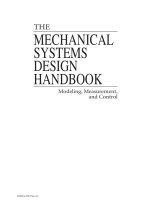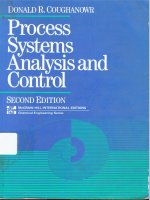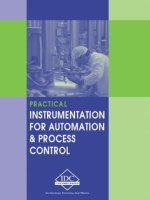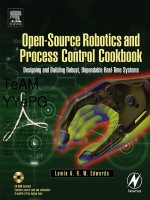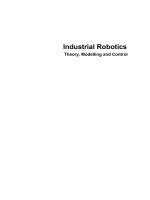Open-Source Robotics and Process Control Cookbook doc
Bạn đang xem bản rút gọn của tài liệu. Xem và tải ngay bản đầy đủ của tài liệu tại đây (2.21 MB, 255 trang )
Open-Source Robotics
and Process Control Cookbook
This page intentionally left blank
Open-Source Robotics
and Process Control Cookbook
Designing and Building Robust,
Dependable Real-Time Systems
by Lewin A.R.W. Edwards
AMSTERDAM • BOSTON • HEIDELBERG • LONDON
NEW YORK • OXFORD • PARIS • SAN DIEGO
SAN FRANCISCO • SINGAPORE • SYDNEY • TOKYO
Newnes is an imprint of Elsevier
Newnes is an imprint of Elsevier
30 Corporate Drive, Suite 400, Burlington, MA 01803, USA
Linacre House, Jordan Hill, Oxford OX2 8DP, UK
Copyright © 2005, Elsevier Inc. All rights reserved.
No part of this publication may be reproduced, stored in a retrieval system, or transmitted in
any form or by any means, electronic, mechanical, photocopying, recording, or otherwise,
without the prior written permission of the publisher.
Permissions may be sought directly from Elsevier’s Science & Technology Rights De-
partment in Oxford, UK: phone: (+44) 1865 843830, fax: (+44) 1865 853333, e-mail:
You may also complete your request on-line via the Elsevier
homepage (), by selecting “Customer Support” and then “Obtaining
Permissions.”
Recognizing the importance of preserving what has been written, Elsevier prints its
books on acid-free paper whenever possible.
Library of Congress Cataloging-in-Publication Data
(Application submitted.)
British Library Cataloguing-in-Publication Data
A catalogue record for this book is available from the British Library.
ISBN: 0-7506-7778-3
For information on all Newnes publications,
visit our Web site at www.books.elsevier.com
04 05 06 07 08 09 10 9 8 7 6 5 4 3 2 1
Printed in the United States of America.
Dedication
v
This book is dedicated to my wife Cristen, in recognition of her uncomplaining
acceptance of yards of PVC conduit in hallways, pounds of gel-cells in the living room,
and never-ending snarls of wire and motors throughout the house.
This page intentionally left blank
Contents
vii
About the Author xi
What’s on the CD-ROM? xii
Chapter 1: Introduction 1
1.1 History of this Book and What You’ll Get From Reading It 1
1.2 Target Readership and Required Skills and Tools 5
1.3 Conventions Used in the Text 7
Chapter 2: Microcontrollers, Single-Board Computers and
Development Tools 9
2.1 The Division of Labor 9
2.2 Candidate Microcontrollers for ‘Hard’ Tasks 13
2.3 The Atmel AVR and its Development Hardware Up Close 17
2.4 Candidate x86-based SBCs for ‘Soft’ Tasks 21
2.5 The Advantech PCM-5820 Single-Board Computer Up Close 27
2.6 Selecting an Inter-Module Communications Protocol 32
Chapter 3: Some Example Sensor, Actuator and
Control Applications and Circuits (Hard Tasks) 41
3.1 Introduction 41
3.2 E2BUS PC-Host Interface 44
3.3 Host-to-Module Communications Protocol 49
viii
Contents
3.4 Stepper Motor Controller 52
3.5 Speed-Controlled DC Motor with Tach Feedback and Thermal Cutoff 70
3.6 Two-Axis Attitude Sensor using MEMS Accelerometer 79
3.7 RS-422—Compatible Indicator Panel 90
Chapter 4: The Linux-Based Controller (A Soft Task) 115
4.1 A Brief Introduction to Embedding Linux on PC Hardware 115
4.2 Configuring the Development System and Creating Our Custom Kernel 117
4.3 The Linux Boot Process—Creating a Bootable CompactFlash Card 123
4.4 Creating a Root Filesystem for our Embedded System 128
4.5 Creating a Bootable Linux System-Restore CD-ROM Disc 136
4.6 Using the Parallel Port as a General-Purpose I/O Interface in Linux 142
4.7 Implementing Graphical Control Interfaces 149
4.8 Infra-Red Remote Control in Linux Using LIRC 175
4.9 Introduction to Machine Vision Using Video4Linux 189
4.10 Customizing Your BIOS—The Structure of a Modern BIOS 201
Chapter 5: Encryption and Data Security Primer 209
5.1 Introduction 209
5.2 Classes of Algorithm 214
5.3 Protecting One-Way Control Data Streams 217
5.4 Protecting One-Way Telemetry 218
5.5 Protecting Bidirectional Control/Data Streams 220
5.6 Protecting Logged Data 222
5.7 Where to Obtain Encryption Algorithms 224
ix
Contents
ix
Chapter 6: Expecting the Unexpected 227
6.1 Introduction 227
6.2 Dangerous Exception Conditions and Recovering From Them 228
6.3 On-Chip vs. Off-Chip Watchdog Hardware 230
6.4 Good Power-On Reset Practices 232
6.5 A Few Additional Considerations for Battery-Powered Applications 235
Chapter 7: Contents of the Enclosed CD-ROM 237
Index 237
This page intentionally left blank
xi
About the Author
Lewin A.R.W. Edwards was born in Adelaide, Australia. He worked for five years
in Melbourne, Australia on government-approved encryption, desktop protection
and data security products for DOS, Windows and OS/2. For the next five years, he
worked in Port Chester, New York for Digi-Frame, Inc., where he designed both the
hardware and firmware of a range of multimedia digital picture frame appliances.
These devices ranged in complexity from small pocket-size still-image viewers up
to fully networked wall-mounted devices with audio and full-motion video support.
He currently lives in New York City and works as a short-range radio digital design
engineer for a well-known manufacturer of wireless security and fire safety products.
His earlier works include Embedded Systems Design on a Shoestring, (a book about low-
cost embedded systems development, principally targeted at ARM7 platforms), as
well as articles on specialized design considerations for the microcontrollers used in
electronic toys, commentary on Universal Plug’N’Play, reverse-engineering Internet
appliances, and other topics of interest.
xii
What’s on the CD-ROM?
Included on the accompanying CD-ROM:
■ A free version of the schematic capture and PCB CAD software used to pre-
pare this book. (Refer to the license agreement included with the software for
usage restrictions and limitations.)
■ Atmel AVR Studio® 4.08.
■ Full schematics and sourcecode for the projects described in this book.
■ Ready-made disk images for the miniature Linux distribution used as a basis
for the book’s PC-side software.
■ Distribution archives of the sourcecode for all GNU software used, along with
application-specific patches, where appropriate.
Introduction
1
C H A P T E R
1
1.1 History of this Book and What You’ll Get From Reading It
Over the course of roughly a year, after completing my first book, I resurrected an old
pet project of building an autonomous submarine (referred to as the E-2 project) with
certain fairly challenging functionality requirements. In the course of developing this
idea, I spent many hours on the Internet and elsewhere, researching techniques for
rapid development of various electromechanical control systems and platforms to run
fairly complex signal-processing algorithms. Although there are, of course, thousands
of useful projects and snippets of information to be obtained from the Internet and
books on hobbyist robotics, I found that nobody else seemed to have my exact priori-
ties. In particular, there is apparently no single reference that gathers together at
least introductory solutions to all the embedded design issues that affected my proj-
ect: a need to use low-cost (open-source) tools and operating systems, a requirement
for several features with fairly hard real-time requirements, and a desire to use cheap,
off-the-shelf consumer grade components wherever possible. Available resources on
many topics concentrate either on very expensive off-the-shelf industrial compo-
nents, or on tightly constrained systems built around a single microcontroller, with
delicately optimized, nonportable code to control peripherals—and a very limited
range of peripheral support, at that. These latter system design restrictions are un-
avoidable when you’re working to tight power requirements, space constraints, or a
rock-bottom bill of material (BOM) cost, but it’s an inordinate amount of effort to
build and tune such systems for a one-off project or a prototype. Furthermore, learn-
ing all the details required to assemble such a system is an enormous task; it’s easy to
get lost in fine-tuning details without ever managing to field a complete, working sys-
2
Chapter 1
tem. Irritatingly, many of the tweaks and most of the careful planning you do to get
that system operational will have to be thrown away if you move into actual produc-
tion, or if you need to build some more units with slightly different components.
What I was searching for while developing the E-2 project was a way to build
various hard real-time modules (sensors and actuators) that could easily and cheaply
be interfaced to a general-purpose computer running Linux. The Linux box served
as a testbed for algorithms which would later be ported down into a smaller, cooler,
more power-efficient processing module of some kind. I needed a solid basis of
known-good code and techniques so that I could strike out from that point and build
my own customized system. I also wanted a simple up-and-running guide to building
embedded Linux distributions. For the initial, nonfieldable prototype of my subma-
rine, I didn’t have an exact idea of how much CPU horsepower I would need in the
final version—so I didn’t want to get tied to a specific microcontroller architecture,
nor did I want to get bogged down in trying to tweak and tune many real-time tasks
on a single microcontroller. I also wanted to use a few peripherals—such as cameras
—which are easiest interfaced through a general-purpose operating system.
These requirements may sound a chord with your own working life. Chances are
you’ve encountered situations where it would be useful to automate some long-term
data-gathering experiment or create a simple automated controller for a program-
ming, manufacturing or other task. In this vein, three other instances where I have
applied the techniques in this book are:
■ The development of a range of successful (commercially-fielded) networked
multimedia appliances, designed for unattended advertising and art-gallery
applications.
■ The development of specialized, almost wholly automatic mechanical failure
testing apparatus for certain consumer electronics articles.
■ Construction of an automatic high-speed datalogger that monitors a radio
link and extracts DTMF messages targeted at specific receivers.
The second item above is of particular interest, because it demonstrates nicely
how this book can be of practical value in process control and testing applications.
During 2002, I briefly worked for a small division of a multinational company whose
3
Introduction
major focus was household and office plasticware. It was most instructive to examine
their automated test fixtures—proprietary systems—and compare the cost and setup
complexity of these fixtures with the relatively low cost and setup time of a simple
Linux-based SBC controlling the same pneumatic actuators and sensors. Clearly,
there is an under-exploited market for low-cost test systems of this type. The pro-
prietary systems in use at this particular facility cost almost $20,000 for a half-dozen
actuators and the associated PLCs, plus uncounted hours of setup time
1
. The control
software for these devices was specialized and not well-understood; in fact, most of
this equipment was standing idle because the people who originally configured it had
left the company. By way of contrast, the same tasks could easily be accomplished
with a regular PC costing a mere few hundred dollars, plus perhaps $200 per actua-
tor for the associated pneumatics. More importantly, the control software for such
a system is a simple C program easily understood and adaptable by any competent
computer science or electronic engineering major; there were several candidates
readily available in the company lab.
Due to the nature of the research which led to this book’s inception, I have
included a sprinkling of naval details within the text, not all of which are directly
relevant to the embedded engineer. If this material is not of interest, you can safely
ignore it without compromising your understanding of the remaining text in any way.
The reason this information is included alongside the “pure” embedded develop-
ment discussion is principally to illustrate the real-world requirements and thinking
that led to various design decisions in the E-2 project. Engineering is not theoreti-
cal science; it is an applied discipline, and it is with this in mind that I use specific
examples to illustrate theoretical points.
You should also note that some of the opinions expressed in this book, if not
exactly controversial (except by Usenet standards—everything on Usenet is con-
troversial!), are at least arguable; for example, the choice of AVR as my real-time
control platform. For this reason, I have provided additional justification for the
decisions I have made in this text. This additional explanation should demonstrate
the reasons I had for choosing specific paths, but it’s expressly not designed to prosely-
1
The system was originally set up by “free” interns, so their time wasn’t rigorously tracked.
4
Chapter 1
tize the AVR to people who have experience with, and prefer, another architecture.
Again, this “bonus material” is not critical to your understanding of the basic con-
cepts presented here, and you can safely skip it if you wish.
Also keep in mind that this book is intentionally not a “bible.” It is not an ex-
haustive coverage of every single nuance of the topics covered; such a work would
span several shelves. The primary goal of this book is to describe and illustrate a
simple, modular, inexpensive methodology for implementing complex embedded
systems, and to present some ready-to-use modules for the reader to adapt to his or
her own projects. The particular emphasis is on realizing end-to-end solutions using
low-cost development hardware and free software tools. By the time you reach the
last few pages, hopefully you should have the following:
■ A functional understanding of the critical “under-the-hood” details required
to bootstrap Linux on x86 platforms.
■ An introduction to the types of problems you will face in using embedded x86
single-board computers as the core of data logging and motion-controlling
systems.
■ Basic information about the Atmel AVR microcontroller family.
■ A practical introduction to building some simple data acquisition and motor
control circuits, and connecting them to PCs.
■ Some basic “primer” information on data security, authentication and
reliability issues as they affect embedded systems.
The underlying idea is that the reader has reasonably intimate experience with
one or other of the topics of Linux application development, or development of
deeply embedded systems—this book is designed to boost you up the leading edge of
your learning curve with the essentials of whichever side of the equation you’re miss-
ing. It also provides the glue that binds these pieces of information together in the
overall context of a fairly complex project. Note, by the way, that I used the titular
word “cookbook” with some diffidence. Purely cookbook engineering—slotting
ill-understood pieces together like Capsela spheres—is never good practice. In this
book, I’m giving you some ready-to-use Capsela pieces, but I’m also telling you how
5
Introduction
and why I made the gears and shafts in each piece, and to some extent how you can
go further and make better pieces for yourself. These explanations are much more
important than the blueprints for the pieces themselves.
When planning a book like this, it’s easy to fall into one of two traps: either
to create a single, monolithic “mega-application” which illustrates all the desired
points, but is extremely difficult to explain succinctly, or on the other hand to break
the topic down into numerous small abstract notes that many readers will have
trouble integrating into real-world projects. I have tried to steer between these two
extremes by breaking the more interesting modules of the E-2 project into a few
small, practical applications together with basically standalone code and enough
theory to modify and extend these applications for your own uses.
Finally, a note to people who own my previous book, Embedded System Develop-
ment on a Shoestring. This book is not designed to be a sequel to that volume, but
it is definitely related material. If you follow the techniques in this book to build a
prototype device, and you later want to squeeze it down into an optimized single-chip
solution, my earlier work will help you understand how to use free GNU tools to get
your software easily ported across to an ARM microcontroller. The principal criti-
cisms I received for that previous book were that it needed to cover a wider range of
information, and that there were too few illustrations, making it a rather dry read.
I’ve listened to these comments and I hope you will find this book satisfies your needs
in both respects. As always, your comments and suggestions are welcome; you can
email me at or visit my web site at />1.2 Target Readership and Required Skills and Tools
Throughout this text, I assume that the reader is a competent C programmer, with
some experience in using (though not necessarily embedding) UNIX-like systems,
specifically Linux. I also assume a very basic level of knowledge of real-time systems
and simple digital electronics. This book is not an introduction to Linux, nor is it an
introduction to the concepts of embedded programming; there are hundreds of such
books already.
6
Chapter 1
In order to follow along with the examples in this book, you will need the
following:
■ An x86-based PC system running Linux. This book was developed using
Fedora Core 1, which can be downloaded for free (or purchased on CD) from
A full Linux distribution is not included with this
book due to disk space constraints. For simplicity’s sake, I suggest you use Fe-
dora Core 1 unless you have special reasons for using a different distribution.
■ Ideally, an x86-based SBC selected from the list in Section 2.5, with a hard
drive and CD-ROM drive attached, and a CompactFlash® card of at least 8 MB
capacity—however, none of these items are absolutely essential.
■ A means for burning AVR microcontrollers. There are numerous schematics
for simple AVR programmers available freely on the Internet, and a minimal
programmer is simple to breadboard. (More on this in Section 2.3). I specifi-
cally recommend the STK500 development board from Atmel, because it is
fully integrated with Atmel’s AVR Studio IDE, and the $79 price is better
value than the effort of building a comparable development system from
schematics.
■ An AVR development environment, or at least an assembler. The projects in
this book were developed using the free Windows®-based AVR Studio® from
Atmel, which is included on the CD-ROM. Pure-Linux shops may prefer to
use the free avrasm assembler, which I have also included. The avrdude pack-
age can be used to burn chips under Linux.
■ An oscilloscope is highly recommended, though not mandatory. When you’re
debugging serial communications protocols in particular, nothing beats being
able to see the actual bits going to and fro. The waveform screenshots in this
book were taken using a Tektronix TDS210 60 MHz two-channel digital
scope.
7
Introduction
1.3 Conventions Used in the Text
Throughout this book, I have attempted to adhere to a single set of conventions:
■ For the sake of consistency, all measurements are given in metric units, except
where they refer to a controlling dimension that was originally specified in
nonmetric units. In the latter case, the controlling dimension is specified in
its native unit, and the metric equivalent is shown in parentheses, as in “The
length of a foot-rule is 12 inches (30 cm).” In some cases, this results in a de-
parture from accepted industry standards; for example, the speed of a seagoing
vessel is normally specified in knots (nautical miles per hour), not ms
–1
.
■ URLs are written in italics, for example, in order to sepa-
rate them from surrounding punctuation.
■ In common with most other technical publications, sourcecode and com-
mand line text that is intended to be typed verbatim is rendered in a
fixed-space font.
■ Occasionally, you will find UNIX commands and library functions mentioned
with the standard nomenclature of command(n), where n is the section con-
taining the manual page for the command in question. For example, you can
find out more about rdev(8) by typing
man 8 rdev at a shell prompt. Don’t
go looking for nonexistent footnotes!
■ When I discuss procedures that access the enclosed CD-ROM from Linux, I
assume that the disk is mounted at /mnt/cdrom, because that is where most
desktop Linux distributions will put it. If you mount it somewhere else, you’ll
need to edit your command-line entry appropriately.
■ All sourcecode and makefiles are designed to be viewed with a tab width of
four character spaces.
This page intentionally left blank
2
C H A P T E R
9
Microcontrollers, Single-Board
Computers and Development Tools
2.1 The Division of Labor
The designer of a complex multi-level project such as the E-2 must frequently juggle
the following conflicting requirements, among others:
■ Hard real-time response requirements of sections of the overall system.
■ The hardware and firmware complexity of interfacing special peripherals
such as cameras, Ethernet networking, 802.11b wireless networking, and others.
■ Bill-of-materials costs for both prototypes and production pieces.
■ Development time.
■ Cost of development tools.
■ Relatively high cost of components designed for embedded systems, as com-
pared to the pricing of comparable-performance, generally-available
consumer products.
It’s a terribly daunting task to approach all of these problems at once, particu-
larly at the start of a project when your exact needs are generally not well-specified.
Limited time or monetary budgets add stress, because there simply may be no days or
dollars spare to be wasted exploring dead-end research paths on the way to a working
system. Furthermore, many of the systems of interest to readers of this book will ei-
ther be unique, or will be produced in very small volumes. For such systems, it’s hard
to justify intense time expenditures researching and fine-tuning noncore features
(i.e., the infrastructure features you have to debug before you can debug the function-
ality you actually want to develop).
10
Chapter 2
The basic methodology I have used to cut through most of this Gordian knot is
as follows: To begin with, I divide all the system processes into two categories, which
I will term “hard” and “soft.” For the purpose of this discussion, hard processes are
defined as direct physical-world interaction tasks where timing and system robust-
ness are likely to be critical to performance and/or safety. Examples in the E-2 system
are: Stepper motor control for rudder and dive planes, battery charge and thermal
monitoring, depth monitoring, propulsion motor control, and bilge sensors. Hard
processes are typically easy to identify and characterize precisely, and can often be
implemented in a small 8-bit microcontroller. In the E-2, we will perform all the hard
tasks using microcontrollers in the AVR series, from Atmel.
By contrast with hard processes, soft processes are not at all mission-critical, and
have relaxed or nonexistent real-time requirements. Generally, soft tasks can crash,
provide erroneous, untimely or downright missing data, and the overall system health
will not be unduly compromised. Examples in the E-2 project are image capture, stor-
age and analysis, data logging, and some telemetry functions. Many soft tasks require
interaction with complex sensory or communications modules such as cameras and
wireless networks. For this reason, it is convenient to use standard off-the-shelf con-
sumer peripherals such as USB webcams, CompactFlash storage media, USB wireless
LAN pods, and others. Interfacing to these sorts of peripherals from a small micro-
controller is often decidedly nontrivial—oftentimes, technical data is hard to come
by, and it’s also frequently difficult to acquire loose sample parts in small quantities.
Prototyping with these parts is also usually difficult.
In the case of low-cost CMOS image sensors, for example, virtually the only way
to get these parts off the shelf is to buy a complete camera and cannibalize it—IF
you can identify the devices in it without microscopic examination, and IF you can
get datasheets! Furthermore, manufacturers of consumer electronics are more or less
constantly refining and costing down their products. You may cannibalize MyWidget
V1.0 and spend many hours getting the components to work in your system, only
to find (when you start to build a second unit, e.g., to replace a lost prototype) that
MyWidget V1.0 has been superseded by V1.1, containing totally different compo
-
nents—maybe even an undocumented ASIC.
11
Microcontrollers, Single-Board Computers and Development Tools
In a similar manner to the way I handled task management, I divide system com-
munications into two classes; control-critical and noncritical. In the case of E-2,
all control-critical data transfers occur within the vehicle itself, between the vari-
ous real-time modules and the main controller. These communications take place
over an internal three-wire SPI-style serial bus. Noncritical communications are, for
example, the ship-to-shore telemetry link. These data streams can be carried using
whatever media and protocols are convenient, with less attention paid to real-time
issues such as lag
2
.
You may wish to pause here and consider the implications of the preceding deci-
sions. In particular, note the implication that hard tasks and control-critical links are
trusted and soft tasks and noncritical links are not trusted. We’re going to be running
all the hard, critical stuff in small microcontrollers carefully programmed “to the
metal,” and—hopefully—completely understood and characterized in all conceivable
situations. The messy stuff like networking, snapping pictures to a hard drive, and so
on, will all be run on a totally separate piece of hardware. If it crashes, it can sim-
ply be reset or shut down with no impact on system survivability. This is important,
because most of the software running on that untrusted piece of hardware wasn’t
developed for embedded use, and it certainly isn’t as well-defined as the software we
custom-engineered into the hard-task controllers.
I should stress that none of the previous discussion is per se an indictment of
the reliability of embedded Linux. It is perfectly possible to build rock-solid control
systems based around a single Linux processor, and there are many such systems in
existence. However, a uniprocessor system requires considerable fine-tuning of the
operating system and application software to achieve a sufficiently real-time end
result
3
. Furthermore, in order to achieve such a result, it is often necessary to use
nonstandard software components intended specifically for embedded systems (real-
2
Obviously, this isn’t true of all telemetry applications. In E-2, the telemetry signal is provided solely
as a convenience to the shoreside operator; it’s not critical that it be strictly real time or that it
implement strenuous error correction.
3
Uncharitable people say of embedded Linux that the standard development technique is to write
the device driver or application the way you think it should be written, then add hardware until it
performs successfully, to the desired approximation of “real time.” The fact that this is so often true
is more an indictment of the developers than the OS, though.
12
Chapter 2
time Linux extensions such as RTLinux, for example). The net effect of both of
these factors is greatly to increase development time, and generally also to tie you to
a specific hardware/software combination. The major advantage gained by the dual-
tier, trusted-vs untrusted layer solution is the ability to lash together functional, but
hard-to-guarantee features on the untrusted layer, using off-the-shelf software and
hardware components.
The crucially important technical advantages of our method of putting together
our complex embedded system are, therefore:
■ The real-time characteristics of any given hard module can be tuned right
down to the CPU-cycle level, if desired.
■ Changes to any one real-time module don’t directly impact the timing prop-
erties of any of the other modules.
■ Standardizing communication protocols amongst the various modules
establishes a “firewall” of sorts, which is useful both for testing purposes (as-
yet-unbuilt modules can be simulated with a piece of external hardware) and
for future upgrades (modules can be replaced with updated versions as long as
a consistent software interface is maintained).
■ Reuse of hardware modules in other projects is very easy, since it is the system
that is project-specific, not the individual parts.
■ Because access to complex peripherals is abstracted at a fairly high layer
(through the operating system running on the untrusted soft-task controller),
it’s possible to swap out these components for functionally equivalent parts
without writing custom device drivers.
In fairness, at this time I should also point out the downsides of the multi-module
way of doing things:
■ The overall bill-of-materials cost for a multi-module system is likely to be
much higher in the long term. This is not likely to be a big factor for proto-
type or short-run construction, where setup costs dominate the unit price.
For mass-production, however, the price advantages of a uniprocessor system
become progressively more attractive. Note, though, that for low-volume or


